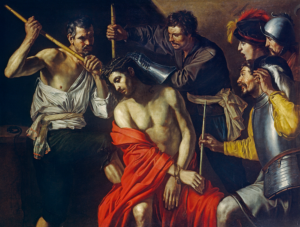Object of the Month: April 2016
The Mocking of Christ
Oil on canvas, c. 1620–30
Unknown French or Dutch (follower of Michelangelo Merisi da Caravaggio)
Active 17th century
Click on the links throughout the article to view additional artists’ works and reference material.
One of the most important (and revolutionary) painters in history was the Italian artist, Michelangelo Merisi da Caravaggio. He broke free from mannerist conventions and stylistic artifice in the late 1500s and set a new path for artistic expression. At first, Caravaggio experimented in such genres as still life and scenes of common people including musicians and gamblers. These subjects were not depicted in mainstream art and neither was his conception of them.
As he earned commissions, he applied this personal vision to familiar Biblical themes. However, Caravaggio’s interpretation of these narratives was anything but traditional. The heightened realism, use of ordinary people as models (whom he presented without an idealistic lens), and novel, masterful compositions attracted many Romans to his genius.
The most influential and singularly astounding element of his style is his dramatic use of light that illuminated his figures as if they emerged from deep shadows; this contrast of light and dark is known as chiaroscuro, a technique also used by Leonardo da Vinci and Rembrandt van Rijn.
Not only the Romans turned their attention to Caravaggio, but soon other artists and patrons around Europe began to take note. As the artistic capital of Italy, Rome was viewed as the final experience for artists seeking to complete their training; many painters visiting from Spain, France, Germany, Flanders and Holland found inspiration in Caravaggio’s fresh approach—including one of the favorites of M&G’s guests, Gerrit van Honthorst.
The unknown French or Dutch author of the present painting likely saw Caravaggio’s paintings first-hand in Rome and sought to emulate his style. He may very well have seen the artist’s conception of this same subject, The Crowning of Thorns, now housed in the Kunsthistoriches Museum, Vienna.
The same characters, a man wearing armor and plumed hat and a torturer with a gaping white shirt, are found in both paintings. Even the “V” shape made by the bamboo reeds above Christ’s head are echoed in each composition. Furthermore, several of the figure types in this painting are similar to models in some of Caravaggio’s paintings.
While M&G cannot claim to have an autograph Caravaggio painting (there are only a handful in America), this painting is the closest we have to the master’s style and is clearly by the hand of an accomplished artist who sought to emulate not only one of the greatest artists of his time, but of all time.
John M. Nolan, Curator
Published in 2016
